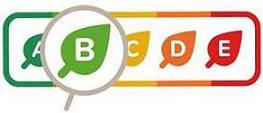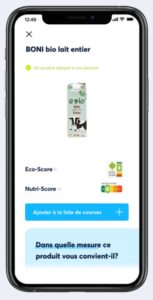En France, l’éco-score classe de A (faible) à E (fort) les produits alimentaires selon leur impact environnemental. Outil d’aide à la décision, il permet d’informer les consommateurs sur l’impact de leurs choix alimentaires afin de les guider au final vers une consommation plus responsable. L’indicateur d’impact environnemental des produits alimentaires gagne du terrain en Europe mais pas uniquement.
Le Royaume-Uni va le tester prochainement
A l’automne prochain et en guise de test, le Royaume-Uni va apposer l’éco-score sur la face avant de certains produits alimentaires en magasins. Les produits seront classés de A+ à G avec des codes couleurs spécifiques (le vert correspondant au produit le plus respectueux de l’environnement et le rouge au produit le moins respectueux de l’environnement). Le système de notation des produits prend en compte différents impacts que le produit peut avoir sur la planète comme la pollution de l’eau, la perte de la biodiversité et les émissions de CO2.

Eco score figurant sur la face avant des packagings alimentaires – Foundation Earth / Source: www.foundation-earth.org
Le système, qui s’inspire des feux de signalisation, a été mis en place par la Foundation Earth, une organisation à but non lucratif qui réunit le géant de l’agroalimentaire Nestlé, des chaînes de supermarché (telles que Marks & Spencer et Sainsbury’s), l’organisme européen d’innovation alimentaire EIT Food (organisme de la Commission Européenne) et des scientifiques spécialisés dans l’alimentation et l’environnement.
Vers un système européen ?
Lancé en France, au début de l’année 2021, par différents acteurs de l’alimentaire (dont Yuka, Marmiton, Open Food Facts et Scan Up), le concept d’éco-score n’est pas nouveau au niveau national. En revanche, ce dernier est pour le moment limité aux applications food (comme Yuka, Scan Up, Etiquettable…) et aux sites marchands.
Le distributeur Carrefour a d’ailleurs lancé récemment le concept sur son site marchand (en plus du nutriscore). Il dévoilera les résultats de son expérimentation en octobre prochain. Une initiative pas vraiment étonnante d’ailleurs lorsque l’on pense à sa démarche pour la transition alimentaire (Act for Food).

Affichage de l’éco-score sur le site de Carrefour/ Source: www.carrefour.fr
Le concept commence à se développer également en Europe. En mars dernier, l’enseigne belge Colruyt a également lancé le concept pour les produits de sa marque propre (Boni) sur son application SmartWithFood. En Allemagne et aux Pays-bas, le discounter Lidl va également tester l’eco-score sur les emballages des produits dans certains de ses magasins.
Assisterons-nous à un éco-score harmonisé en Europe sur les packagings food & drink d’ici 2022 voire 2023 ? Est-ce une vraie solution pour consommer plus durable ? A suivre…
The growing interest of the eco-score label in Europe and in the UK
Eco-labelling system to be trialled in the UK
In the autumn, a trial of a new eco-label labelling on the front of the food and drink packagings will be implemented in the UK. Inspired by the colours of traffic lights, the eco-label will be graded from A+ to G (slighty different from the French one thus) and coded from colour green to red (corresponding to the most environnemental friendly product to the worst). It takes into account several aspects such as water usage and pollution and carbon emissions. This indicator will help consumers’ to choose more sustainable products.

Foundation Earth front-of-pack environmental scores/ Source: www.foundation-earth.org
This new labelling system has been set up by Foundation Earth, a new non-profit organisation supported by the UK government and which includes food giant Nestlé, several brands (such as Marks & Spencer and Sainsbury’s) and the EU-funded food innovation initiative EIT Food. The roll up of the trial will be on products sold by Marks & Spencer, Costa Coffee and other UK leading food brands.
Towards a generalized environmental labelling on food products in Europe?
The concept of eco-score (which is based on the Nutri-score model) was launched in France in January by several food actors (such as Yuka, ScanUp, Open Food Facts…). This traffic light eco-score rates products from A (green) to E(red). For the moment, in France, you can only see this eco-score label in food applications (such as Yuka and Scan Up) and online websites. Besides, the supermarket giant Carrefour has just offered an eco-score notation trial for all the products sold on its website. The results of this trial will be revealed in October.

The retailer Carrefour displays the eco-score on all the products sold in its website Carrefour.fr /Source: www.carrefour.fr
There’s also a growing interest for this concept outside France. Indeed, the Belgium retailer Colruyt also launched the eco-score notation for the products of its brand (Boni) through its SmartWithFood app. In Germany and the Netherlands, the German discounter Lidl also implemented the food labelling on products in some of its stores.
The implementation of this food labelling clearly shows a raising awareness from industrials to provide more environmental information to consumers’. Would we have an harmonised system in Europe? Is that eco-score labelling the solution for more sustainable shopping habits? To follow closely…
Interesting and useful links:
https://www.foundation-earth.org/
https://scanup.fr/eco-score-impact-environnemental-produits-alimentaires/
https://fr.openfoodfacts.org/eco-score-l-impact-environnemental-des-produits-alimentaires
https://docs.score-environnemental.com/
https://www.carrefour.com/fr/actuality/carrefourecoscore
https://www.carrefour.com/en/actuality/carrefourecoscore
https://www.carrefour.fr/engagements/act-for-food
https://www.colruytgroup.com/wps/portal/cg/fr/accueil/histoires/Campaigns/Eco-Score
https://www.colruytgroup.com/wps/portal/cg/en/home/brands/our-brands-smart-with-food

